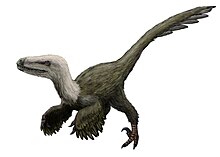Kansaignathus
| Kansaignathus | |
|---|---|

| |
| Life reconstruction of Kansaignathus | |
| Scientific classification | |
| Domain: | Eukaryota |
| Kingdom: | Animalia |
| Phylum: | Chordata |
| Clade: | Dinosauria |
| Clade: | Saurischia |
| Clade: | Theropoda |
| Family: | †Dromaeosauridae |
| Clade: | †Eudromaeosauria |
| Subfamily: | †Velociraptorinae |
| Genus: | †Kansaignathus Averianov & Lopatin, 2021 |
| Type species | |
| †Kansaignathus sogdianus Averianov & Lopatin, 2021
| |
Kansaignathus (
Discovery

The
The type specimen is reposited at the Borissiak Paleontological Institute at the Russian Academy of Sciences in Moscow. It was given the designation PIN 2398/15 and consists of a single partial dentary bone. Additional material, which was also collected in the 1963-1964 expeditions, was described by A.K. Rozhdestvensky in 1977.[3][4]
This additional material included PIN 2398/16 and 2398/1 (fragments of a
Description
Kansaignathus is a small-bodied dromaeosaur which was probably similar in size to Velociraptor. The authors of its description estimate that it was probably about 2 metres (6.6 ft) long,[2] which is similar to seize estimates for Velociraptor[5] and Dineobellator.[6]
In their description of the holotype, Averianov and Lopatin distinguish Kansaignathus from other dromaeosaurs by the presence of several autapomorphies. It has a thin and deep profile of the dentary, parallel edges along the dentary's length (rather than tapering towards the front of the snout), a facet on the posterior-ventral process of the dentary to articulate with the splenial bone, two rows of vascular foramina on the outside edge of the jawbone, and interdental plates which have merged completely with the jaw.[2]
The additional post-cranial material described by the authors in their subsequent publication was not included as part of the holotype specimen. However, the authors are confident in their assignment of the material to the same genus, and the anatomical characters from this material is used in their phylogenetic analysis.[3]
Skull

The only portion of the skull which was preserved is the right
None of the teeth are preserved, but the shape of the alveoli indicates that the teeth would have likely been mediolaterally flattened and increase in size towards the anterior end of the jaw until the ninth tooth position, when they decrease in size again. Two partially-grown teeth are preserved in the sixth and twelfth tooth positions, but they were in the early stages of growth when the animal was fossilized, so they do not convey much information about the in-life nature of the animal's teeth.[2]
Postcranial skeleton
Additional material from Kansaignathus was know about at the time of its initial description, but it was initially believed to belong to a new taxon.[2] It wasn't until 2023 when the material was reviewed in detail that most of these bones were referred to the genus. This referral was based on their occurrence at the same locality as the holotype and a lack of evidence for multiple dromaeosaurid taxa in the similarly-aged Bissekty and Bayan Shireh formations.[3]
The
The holotype also preserves two of the
Lastly, a
Classification
In their description of Kansaignathus, Averianov and Lupatin conducted a
Averianov and Lupatin suggest the implications that the discovery of Kansaignathus has for the biogeography of dromaeosaurs during the middle and late Cretaceous. They hypothesize that velociraptorines originated in North America before migrating to Asia and diversifying there during the Cretaceous and dispersing back into Laramidia. They are also uncertain as to the relationship between Kansaignathus and its contemporary genera in Kazakhstan and Uzbekistan, such as Itemirus and several teeth known from the Bostobe Formation, due to the incomplete nature of these remains.[2]
With the description of the additional material in 2023, Averianov and Lupatin conducted their phylogenetic analysis a second time with the new character data of the referred material included. This did not fundamentally alter the placement of Kansaignathus in their final tree, and they stated that the higher-level interrelationships between dromaeosaurs is still uncertain.[3]
Paleoecology
The fauna of the
However, the Yalovach Formaiton is considerably less fossiliferous than the Bissekty Formation, and Kansaignathus is the only named
The most well-studied animals from this formation are the crocodyliformes, of which there are two. The first, Kansajsuchus, is known from a disarticulated and partially complete skull.[13] The second, Tadzhikosuchus, is known from less material and is possibly dubious and undiagnostic.[14]
Very little has be inferred about the relationships between different animals in these ecosystems because of the fragmentary and sparse nature of the remains,[7] but some authors have commented on potential ongoing or future study in the area.[3]
See also
- 2021 in archosaur paleontology
- 2023 in archosaur paleontology
- List of Asian dinosaurs
- USSR)
- Timeline of dromaeosaurid research
References
- ^ Matthew Carrano (2006). "Kansai, FKA-7a (Cretaceous of Tajikistan), Also known as Kansay". The Paleobiology Database.
When: Yalovach Formation, Early/Lower Santonian (85.8 - 83.5 Ma), Upper part of the Yalovach Formation
- ^ S2CID 239088573..
- ^ S2CID 257453407.
- ^ Rozhdestvensky, A.K. (1977). "Kansai locality of Cretaceous vertebrates in Fergana". Yearbook of the All-Union Paleontological Society 20, 235-247.
- ^ PMID 32218481.
- ^ a b c Averianov, A.; Sues, Hans-Dieter (2012). "Correlation of Late Cretaceous continental vertebrate assemblages in Middle and Central Asia". Journal of Stratigraphy. 36 (2): 462–485.
- .
- S2CID 249650142.
- S2CID 140673522.
- S2CID 140665908.
- S2CID 253480874.
- .
- ^ Storrs, G. W.; Efimov, M. B. (2000). "Mesozoic crocodyliforms of north-central Eurasia". In Michael J. Benton; Mikhail A. Shishkin; David M. Unwin; Evgenii N. Kurochkin (eds.). The Age of Dinosaurs in Russia and Mongolia. Cambridge University Press. pp. 402–419.


